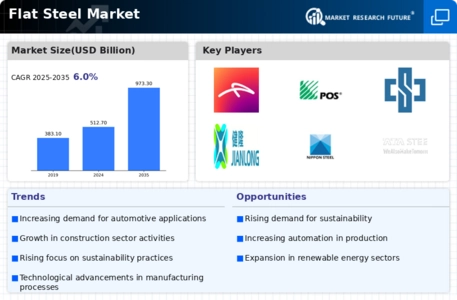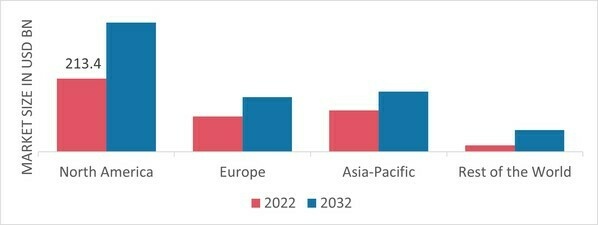Market Trends
Introduction
As we enter 2024, the Flat Steel Market is poised for significant transformation driven by a confluence of macro factors. Technological advancements in production processes, such as automation and digitalization, are enhancing efficiency and reducing costs, while regulatory pressures aimed at sustainability are pushing manufacturers towards greener practices. Additionally, shifts in consumer behavior, particularly the increasing demand for lightweight and high-strength materials in automotive and construction sectors, are reshaping product offerings. These trends are strategically important for stakeholders, as they not only influence competitive positioning but also dictate the need for innovation and adaptability in an evolving market landscape.
Top Trends
-
Sustainability Initiatives
The flat steel market is increasingly influenced by sustainability initiatives, with major players committing to carbon neutrality by 2050. For instance, ArcelorMittal aims to reduce CO2 emissions by 35% by 2030. This shift is driven by regulatory pressures and consumer demand for greener products, leading to investments in electric arc furnaces and renewable energy sources. The operational impact includes higher initial costs but potential long-term savings and market competitiveness. -
Digital Transformation
Digital technologies are reshaping the flat steel industry, with companies adopting IoT and AI for enhanced operational efficiency. For example, ThyssenKrupp AG has implemented smart manufacturing solutions that improve production processes. This trend is expected to reduce downtime and increase productivity, with measurable improvements in supply chain management. Future developments may include further automation and data analytics integration, driving innovation. -
Increased Demand from Automotive Sector
The automotive sector's demand for flat steel is surging, driven by the shift towards electric vehicles (EVs) and lightweight materials. Nucor Corporation reports a significant increase in orders for high-strength steel used in EV manufacturing. This trend is reshaping product offerings and necessitating investments in R&D for advanced materials. The operational impact includes adapting production lines to meet evolving specifications and standards. -
Trade Policies and Tariffs
Trade policies and tariffs continue to impact the flat steel market, with countries imposing tariffs to protect domestic industries. For instance, the U.S. has maintained tariffs on imported steel, affecting pricing and availability. This trend creates challenges for international trade and may lead to increased domestic production. Future implications include potential retaliatory measures and shifts in global supply chains. -
Technological Advancements in Production
Technological advancements in steel production, such as the development of advanced high-strength steel (AHSS), are gaining traction. Companies like JFE Steel Corporation are investing in new production techniques to enhance material properties. This trend is expected to improve product performance and reduce weight in applications. The operational impact includes the need for updated manufacturing processes and training for skilled labor. -
Circular Economy Practices
The adoption of circular economy practices is becoming prevalent in the flat steel market, with companies focusing on recycling and reusing materials. For example, POSCO has implemented initiatives to recycle steel scrap, reducing waste. This trend not only aligns with sustainability goals but also lowers raw material costs. Future developments may include enhanced recycling technologies and partnerships with other industries. -
Regional Market Dynamics
Regional dynamics are shaping the flat steel market, with Asia-Pacific leading in production and consumption. China remains a dominant player, with Jiangsu Shagang Group expanding its capacity. This trend influences pricing and competition, as regional players adapt to local demand. Future implications may include shifts in market share and increased investment in emerging markets. -
Focus on Quality and Innovation
Quality and innovation are becoming critical differentiators in the flat steel market, with companies investing in R&D to develop superior products. Tata Steel has launched new grades of steel tailored for specific applications, enhancing performance. This trend drives competition and may lead to higher prices for premium products. Future developments could see increased collaboration between manufacturers and end-users to innovate. -
Supply Chain Resilience
The need for supply chain resilience has become paramount, especially post-pandemic, with disruptions prompting companies to reassess their strategies. Firms like Severstal Russian Steel are diversifying suppliers to mitigate risks. This trend impacts inventory management and logistics, leading to increased costs but improved reliability. Future implications may include greater investment in local sourcing and technology to enhance supply chain visibility. -
Emerging Markets Growth
Emerging markets are witnessing significant growth in flat steel consumption, driven by urbanization and infrastructure development. Countries like India are ramping up production capabilities, with SAIL expanding its facilities. This trend presents opportunities for investment and partnerships in these regions. Future developments may include increased competition among global players to capture market share in these high-growth areas.
Conclusion: Navigating the Flat Steel Market Landscape
As we approach 2024, the flat steel market is characterized by intense competitive dynamics and notable fragmentation, with both legacy and emerging players vying for market share. Regional trends indicate a shift towards localized production and supply chains, driven by geopolitical factors and sustainability mandates. Vendors must strategically position themselves by leveraging advanced capabilities such as AI for predictive analytics, automation for operational efficiency, and sustainable practices to meet evolving consumer demands. Flexibility in production processes will also be crucial for adapting to market fluctuations. Companies that successfully integrate these capabilities will likely emerge as leaders in this competitive landscape, while those that fail to innovate may struggle to maintain relevance.

















Leave a Comment